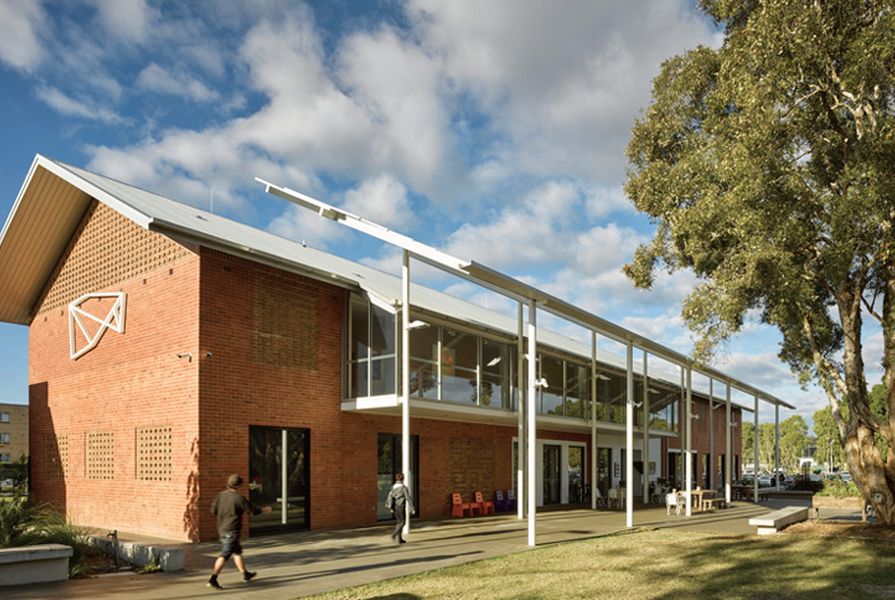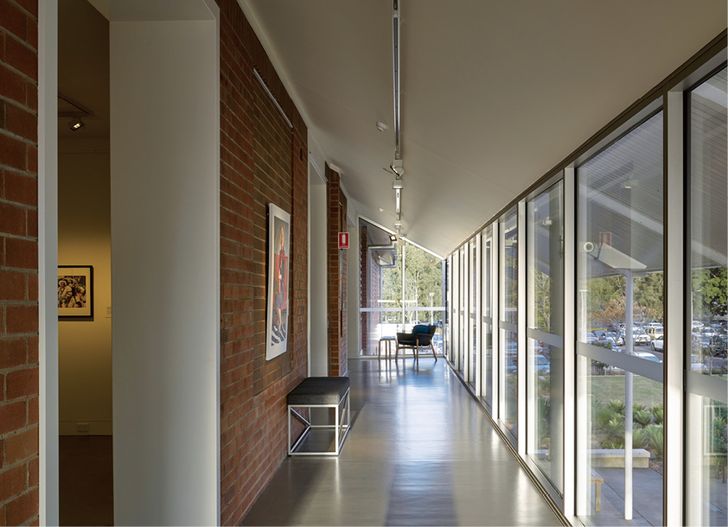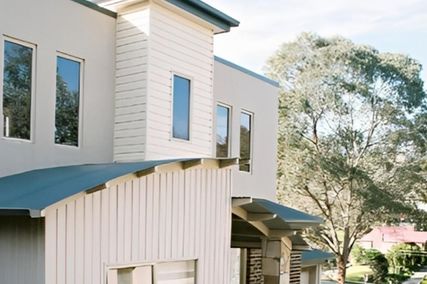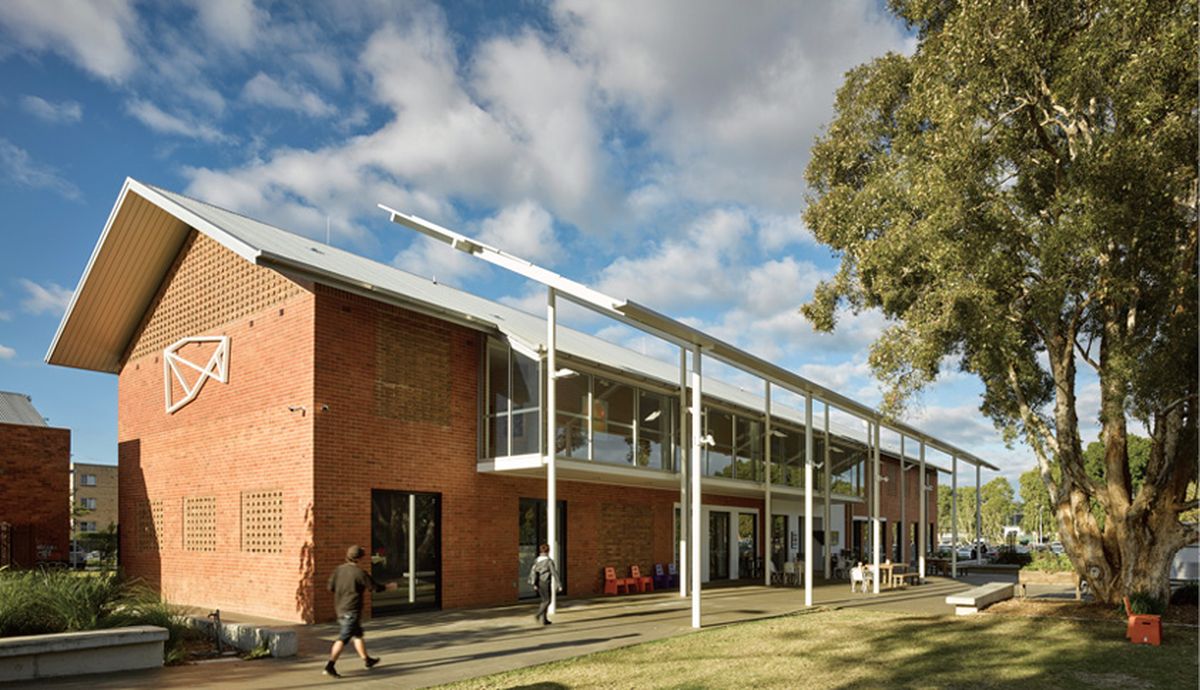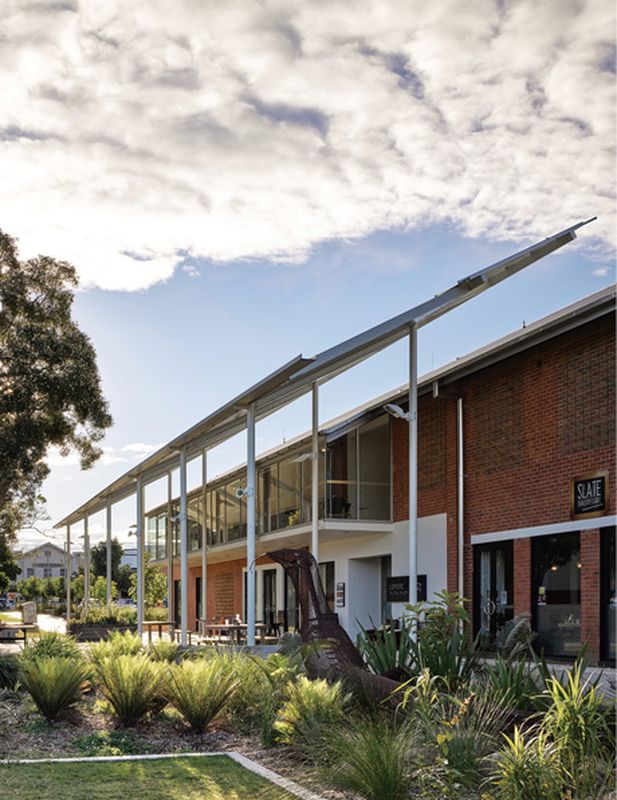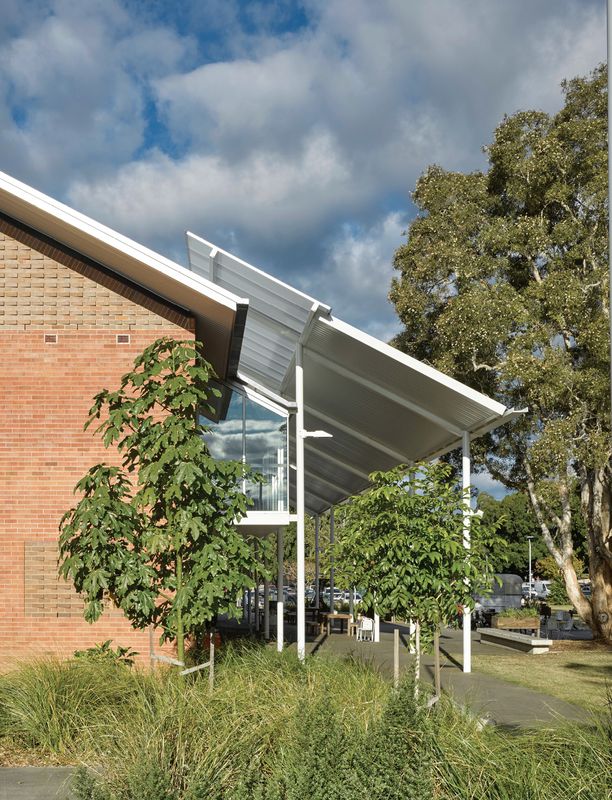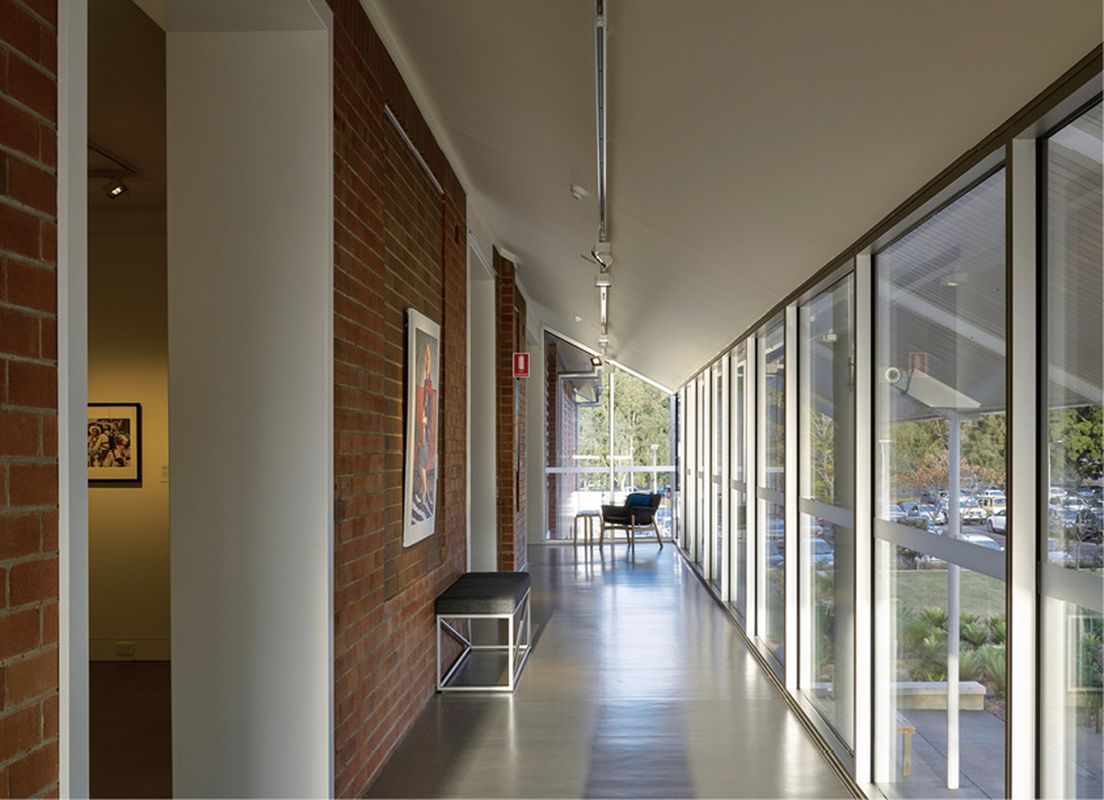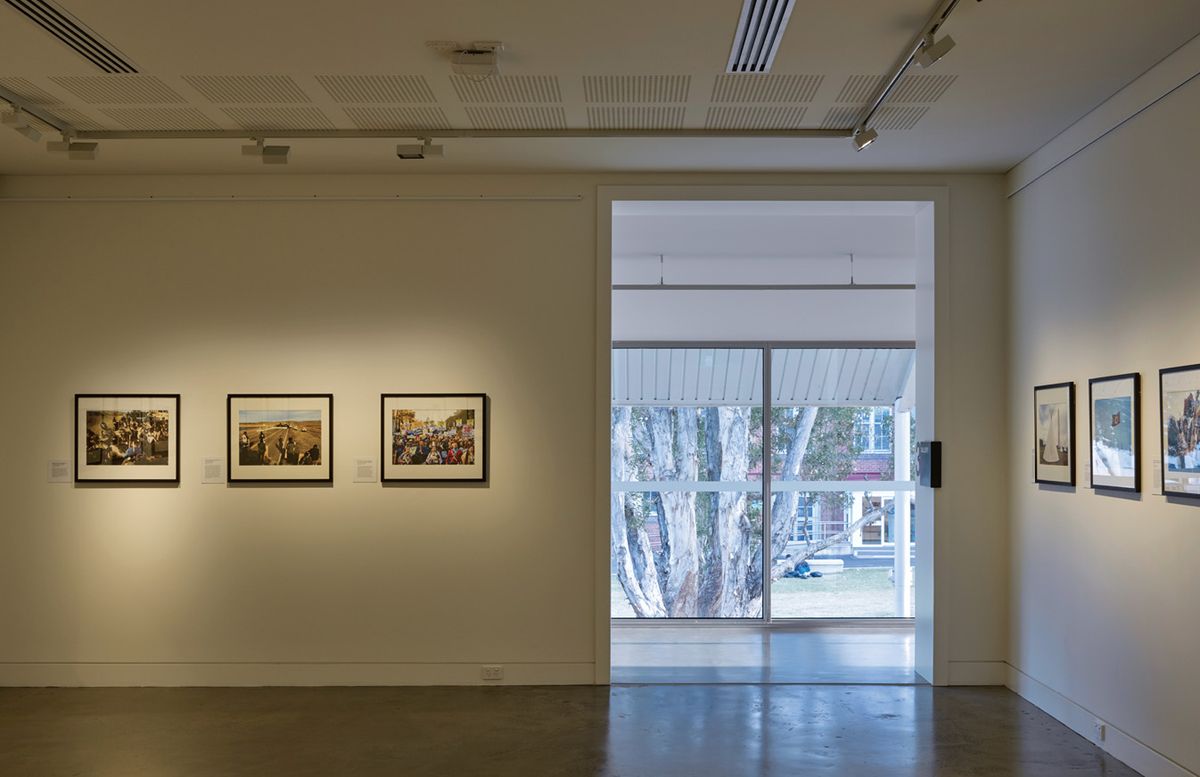Arriving at the street address of the Lismore Regional Gallery, I am met by a carpark at what feels like the building’s back door. A low-slung agricultural roof is festooned with solar panels, while underneath it a couple of people move through a yoga routine, undisturbed by my presence. On approaching the entry, however, I am given a clear axial view through the building, which suggests a public path that connects to a grassed quadrangle beyond and is a clue that all is not what it seems.
The Lismore Regional Gallery is an adaptive re-use of “C-Block,” a nondescript 1960s red-brick building that was part of the former Lismore High School. C-Block forms the north-eastern face of a three-sided courtyard or quadrangle, open to the south-east. The remaining sides of the quadrangle are provided by two heritage-listed buildings designed by the New South Wales Government Architect’s Office. These grand three-storey brick buildings, also formerly Lismore High School buildings, are now home to the Lismore Library and the Northern Rivers Conservatorium and set the tone for this regional town’s thriving cultural hub.
Standing in the quadrangle, you can easily make out the main pedestrian connection to Keen Street to the north-west. This connection stitches the gallery and its surrounds directly into the heart of Lismore’s town centre, and from here it is clear that this face of the building is the main public entry. A pedestrianized street leads visitors in through a grandly scaled colonnade that supports a new fly roof above. Cafe tables sit under this roof and look out onto the quadrangle, encouraging occupation of the new civic space. A landscaped garden adjacent to the colonnade catches rainwater from the fly roof above.
The new work is clearly articulated off the side of a 1960s red-brick building. A fly roof and colonnade encourage occupation of the outside space.
Image: Christopher Frederick Jones
This project has been a long time in the making. The need for a regional gallery in the area was first raised in an article in the local newspaper in 1901, yet more than fifty years passed before Lismore Regional Gallery finally began in 1953, as a result of the formation of the Lismore Arts Trust. In 1954 Lismore City Council granted the Trust the use of the lower floor of the Trench Building in Spinks Park, a c.1908 building that initially served as the Lismore Branch of the Government Savings Bank of NSW. The building was well used but presented many challenges to successive curators and seriously limited the types of works that could be shown due to its domestic scale and a lack of climatically controlled spaces. It took a further sixty-two years to gain sufficient momentum and secure funding for a facility that could match the aspirations of the community, gallery director Brett Adlington and the local council.
The pursuit of a new gallery space has been an exercise in dogged persistence led by Jenny Dowell, arts patron and Lismore City Mayor from 2008 to 2016. The success of the project is in no small part due to the architect listening carefully to the client, respecting the existing building and the site and being clever with the relatively small budget. These are the skills of thoughtful and creative architects, but rarely are they applied as successfully as they have been in this project. Careful and incisive questions that asked which resulted in key decisions being reached early on in the project: keep the existing building, do not mess with the form and allocate the money saved by retaining the building to the development and improvement of the public realm. The result is a quiet, thoughtful and very successful building that is appropriate for, and belongs to, the town. The locals have thoroughly embraced this building. It has strengthened the community and has allowed Adlington and his curators to reach a wider audience across all ages and demographics. Adlington reports that the gallery has received more than 100,000 visits in the first year (three times the number of the previous year in the gallery’s old building).
Lismore’s subtropical climate exposes the city to frequent floods. Because of this, all of the gallery’s fixtures, fittings and valuable contents are on the first floor, elevated above the flood level.
Image: Christopher Frederick Jones
The building sits in a flood zone and in 2017, as the project was awaiting the installation of its lift, floodwaters rose to a staggering three metres above ground level. The lift was carried off in its packing crate, finding a berth somewhere in the quadrangle. Luckily, in every other way the building was prepared for such an event and the opening was only delayed by two months.
All of the valuable fixtures, fittings and contents of the building are located above the ground floor and therefore above the flood level. Gallery spaces and art storage are on the first floor and the air handling plant is housed in the roof space. The ground floor contains the entry foyer, office space, community rooms, artist-in-residence space, loading dock and cafe. Most of the valuable equipment and contents within these spaces can be quickly moved up to the first floor if there is a threat of a flood.
The existing 1960s school building had a relatively narrow and long plan. To maximize the plan area for the galleries, the circulation has been plugged onto the outside edges of the building, freeing up the full width of the plan. These glazed circulation spaces hang delicately off both sides of the first floor and fit neatly under the extended eave of the pitched roof. Passers-by can see gallery visitors moving between rooms and those inside are able to look out to the quadrangle between exhibitions. The really clever bit is that these appendages form an integral part of the air handling strategy for the gallery. Keeping a constant temperature and humidity level in a gallery is vital in order to be able to exhibit borrowed works and the circulation spaces form a buffer or airlock between the outside and the open-plan gallery spaces. The main gallery space at the eastern end of the building can be completely isolated and therefore controlled within the required parameters. As a result, the gallery has been able to show works by significant international artists such as Anish Kapoor, Katharina Grosse and Wolfgang Tillmans.
Circulation has been “plugged onto” the exterior of the long, narrow original building, freeing up the full width of the plan for exhibition space.
Image: Christopher Frederick Jones
A stark reminder of the floods that affect the Northern Rivers region can be found in two places. The first is a series of lines marked on the brick wall in the north-west corner on the ground floor, noting the high-water mark from past floods (the 2017 flood is at the top, just below the soffit of the floor above). The second is slightly less obvious. At the eastern end of the first-floor corridor above the loading dock is a large glazed casement window that can open outward. This is the emergency escape in case someone is caught in the building during a flood and requires rescuing by a passing boat.
In every aspect of this project, the collaborative team has shown inventiveness, pragmatism and a strong sense of driving the community dollar hard. Shading roofs are drawn from the original pitch and, on the south side, hover above the existing building to allow hot air to escape and permit views out to the quadrangle. Existing windows and the gable ends have been filled in with a brick that is similar to the original but has a subtle fish-scale pattern to show that it is new work. Old hardwood joists have been repurposed as the soffit in the public areas of the ground floor. The detailing is simple and picks up on the 1960s institutional aesthetic. There is much to like in this building: little has been wasted, it is quiet, it has provided a much-needed catalyst for the local arts community to thrive and it is civic in its ambition. Only a few would recognize the old terrazzo toilet partitions now being used as the reception desk, but those who do will know that this building shares some history with the people visiting it.
Footnote
1. The federal government committed $2.85 million toward the project in 2015 as part of the National Stronger Regions Fund. The remainder of the $5.8 million project cost was covered by $410,000 from the NSW state government, $500,000 from the Margaret Olley Arts Trust and the remainder from Lismore City Council and other public donations. See northernstar.com.au/news/58-million-gallery-ready-to-open-its-doors/3244015/ (accessed 24 October 2018).
Credits
- Project
- Lismore Regional Gallery
- Architect
- Dominic Finlay-Jones, Phil Ward, Daniel Mann, Amber Garde, Fraser Williams-Martin
- Architect
-
Dominic Finlay Jones Architects in Association with Phil Ward
- Consultants
-
Certifier
Techton Building Services
Compliance and accessibility BCA Check
Electrical engineer Webb Australia Group
Energy assessment Partners Energy
Hydraulic consultant Glen Monteith
Landscape architect Plummer and Smith
Mechanical engineer Hawkins Ross Jenkins
Planner Newton Danny Chapelle
Quantity surveyor QS Plus
Structural engineering Westera Partners
- Aboriginal Nation
- Built on the land of the Bundjalung, Widjabul people.
- Site Details
-
Location
Lismore,
NSW,
Australia
Site type Rural
- Project Details
-
Status
Built
Category Public / cultural
Type Adaptive re-use, Culture / arts
Source
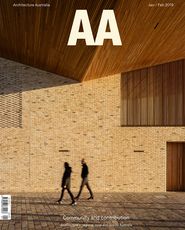
Project
Published online: 13 May 2019
Words:
Ashley Dunn
Images:
Christopher Frederick Jones
Issue
Architecture Australia, January 2019

